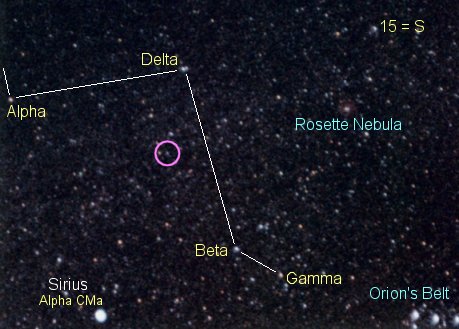 While HR 2622 Monocerotis is spectroscopically classed as a giant-
subgiant, which would make it rather unusual for planet discovery,
it has the characteristics of an ordinary hydrogen-fusing
dwarf (or possibly subgiant).
While HR 2622 Monocerotis is spectroscopically classed as a giant-
subgiant, which would make it rather unusual for planet discovery,
it has the characteristics of an ordinary hydrogen-fusing
dwarf (or possibly subgiant).
THE PLANET
The circle shows the location of the class G giant-subgiant (?)
star HR 2622, found in the constellation Monoceros. The planet, whose mass is at least 1.13
times that of Jupiter, orbits with a period of 119 days at a close
average distance of 0.49 Astronomical Units (73.5 million
kilometers, 46 million miles), only 27 percent bigger than the
orbit of Mercury. Even though fairly close to its star, the orbit
is still modestly eccentric, the planet ranging between 0.63 and
0.35 AU (the latter closer than Mercury is to the Sun).
|
 While HR 2622 Monocerotis is spectroscopically classed as a giant-
subgiant, which would make it rather unusual for planet discovery,
it has the characteristics of an ordinary hydrogen-fusing
dwarf (or possibly subgiant).
While HR 2622 Monocerotis is spectroscopically classed as a giant-
subgiant, which would make it rather unusual for planet discovery,
it has the characteristics of an ordinary hydrogen-fusing
dwarf (or possibly subgiant).
 While HR 2622 Monocerotis is spectroscopically classed as a giant-
subgiant, which would make it rather unusual for planet discovery,
it has the characteristics of an ordinary hydrogen-fusing
dwarf (or possibly subgiant).
While HR 2622 Monocerotis is spectroscopically classed as a giant-
subgiant, which would make it rather unusual for planet discovery,
it has the characteristics of an ordinary hydrogen-fusing
dwarf (or possibly subgiant).